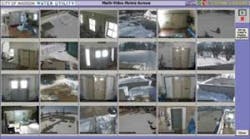By Greg Santos
In a modern water or wastewater control system with high speed networks, video surveillance for security, control and automation purposes can use the existing plant network to interface with Supervisory Control and Data Acquisition (SCADA) systems and HMIs, such as Wonderware, Rockwell and GE Fanuc. However, many control systems in the water industry today do not use high speed networks and still communicate via slower connections.
While some video systems are designed for low bandwidth networks, there are still many remote sites that have insufficient communications, making it difficult for video systems to operate effectively. These include DC telephone circuits, tone (FSK) communications, proprietary radio networks, extremely slow networks (300 bps), and others.
The simplest and fastest upgrade is to install a Cellular Gateway. With data rates up to 2 Mbps, a cellular connection can handle most remote site communication needs.
The term Cellular Gateway refers to a device that acts as an interface between a control room computer or LAN and a remote site through a cellular data connection. Setting up a cellular gateway is often simpler and much less expensive than installing a point-to-point wireless system.
Network Layout
The Longwatch Video System is one example of a system designed for low-bandwidth operation. Within the system, multiple video cameras at a remote site connect to a Video Engine which archives all live video data onto an on-board hard drive while simultaneously transmitting video data to the control room at a bandwidth and timing selected by the operators. For example, although the system may be acquiring video data at 80 kbits/sec from a camera, the Video Engine may be configured to send data at a lower rate, say 5 or 10 kbits/sec. The transmission rate depends on the number of cameras that need to transmit at the same time, and the ability of the cellular connection to accommodate the bit rate.
The cellular gateway device resides at the same location as the Video Engine. Once the cellular gateway is configured, it is assigned a unique, static IP address. With built in port-forwarding capabilities, the gateway is able to act as a portal into the remote network. Over this connection, operators at an HMI station can pan, tilt and zoom remote cameras, request playback of archived images, and place one or more cameras into "live mode," where they transmit real-time video.
In many applications, there is no need to watch high-resolution images from all cameras at all times. Instead, such systems can send images on a regularly-scheduled basis at lower resolution. If an intrusion alarm, process alarm, or a scheduled event occurs–such as taking a sample from a tank or lagoon –the system or the operator can give all the available bandwidth to a single camera so that faster, higher resolution images can be sent live.
Because all live video is archived, operators can "go back in time" and ask to see video that occurred ten seconds, ten minutes or ten hours before an event. This capability makes it unnecessary for the system to transmit high resolution video at all times.
Network Security
Security is a consideration for virtually everyone deploying in remote environments today. Advantages built into cellular networks make the data communications inherently more secure than many other types of wireless networks. However, when considering a remote wireless deployment, one should be concerned not only with securing the data, but also with securing the management of the remote devices.
Additional end-to-end security can be implemented between the remote site and the subscriber's central office by using IPsec encryption.
Network layout for a Longwatch Video Surveillance System. Multiple cameras, PLC, door access switches and other hardware connect to a Longwatch Video Engine.
Cellular Service
Cellular service carriers can be divided into one of two categories: GSM or CDMA.
GSM (Global System for Mobile Communications) is the dominant global standard for wireless communications. Wireless carriers such as T-Mobile and AT&T Wireless deliver GSM in North America. A listing of international carriers can be obtained on the GSM World website at http://www.gsmworld.com.
CDMA (Code Division Multiple Access) is a wireless technology delivered in the U.S. by carriers such as Sprint PCS and Verizon Wireless. Coverage maps for CDMA carriers are available at http://www.cdg.org.
Instead of watching live video from 24 remote sites, this water company schedules each site to send a short video clip every five minutes. If any site detects an intruder or an alarm, it can switch to live video immediately.
Both GSM and CDMA support different data transfer technologies. These technologies offer different data transfer throughput and speed capability. The cellular gateway device will have the ability to support one or more of these data transfer standards depending on the cellular carrier you chose.
Wireless carriers typically charge customers by the number of Megabytes (Mb) or Kilobytes (Kb) transmitted per month. These rate plans vary from carrier to carrier but typically involve several rate plan options structured in the following format:
$X per month for up to Y Mb data + $Z per Kb exceeding Y
Other rate plan options are available depending on the specific carrier and application usage profile. These plans may include provisions for unlimited usage, data pooling (usage spread across a number of devices), or time-of-day discounts. Monthly charges of $7.99 for 1MB to $69.99 for unlimited data access are typical rates, but can be more or less expensive depending on data usage plans.
Service Testing (Site Survey)
Completing a full site survey prior to integration is a necessary step in ensuring the successful implementation of the cellular gateway device. A site survey consists of measuring the Radio Frequency (RF) signal strength of the cellular provider's network you have chosen. This series of tests must be performed on the site of final installation using one of the following devices:
- Cellular Gateway (Recommended)
- Cellular Phone
How to use a cell phone for a basic site survey: http://www.wpsantennas.info/pdf/testmode/FieldTestModes.pdf
- Cellular AirCard
It is recommended to obtain a cellular gateway device similar to the model which will be used prior to surveying the site. This will ensure the most accurate site survey possible and will give you the ability to become familiar with the device prior to integration.
Remote sites, such as this water tower, are ideal locations for using cellular communications to transmit video surveillance images.
The best throughput comes from placing the device in an area with the greatest Received Signal Strength Indicator (RSSI). RSSI is a measurement of the Radio Frequency (RF) signal strength between the base station and the mobile device expressed in dBm. The better the signal strength, the less data retransmission and, therefore, better throughput.
Going Cellular
Troubleshooting, field response time, site safety and personnel security can all be improved with video from remote sites such as wells, tanks and pumping stations. Using cellular communications offers a flexible, high bandwidth and cost effective solution for utilities looking to install video surveillance equipment in remote locations. Because of the extensive wireless cellular backbone already in place across North America and much of the world, cellular devices rarely encounter reception or line-of-sight related issues that plague other wireless networking systems.
Cellular gateways have the ability to be moved from one location to the next without fear of network upset. This makes cellular networking ideal for those looking for adaptable, deployable video solutions that may be used for surveillance of intermittent problem areas. WW
About the Author:
By Greg Santos is a Senior Application Engineer for Longwatch, Norwood, MA.
- Determine which sites will require a Cellular Gateway device.
- Determine which cellular providers are available in your area
Use http://www.wirelessadvisor.com - Find cellular towers located in your area to estimate operability.
Use http://www.antennasearch.com/ - Perform preliminary Site Surveys at your target sites.
- Select the Cellular Service Provider.
- Procure Equipment, including Cellular Gateway, Antenna, Lighting Suppression, Cabling, and mounting hardware.
- Activate the hardware with the Service Provider you have chosen.
- Install/Provision the gateway and test communications.
- Test and tune communication from the Video Control Center location.
- Configure the Longwatch Video Control Center for proper communication.
More WaterWorld Current Issue Articles
More WaterWorld Archives Issue Articles






